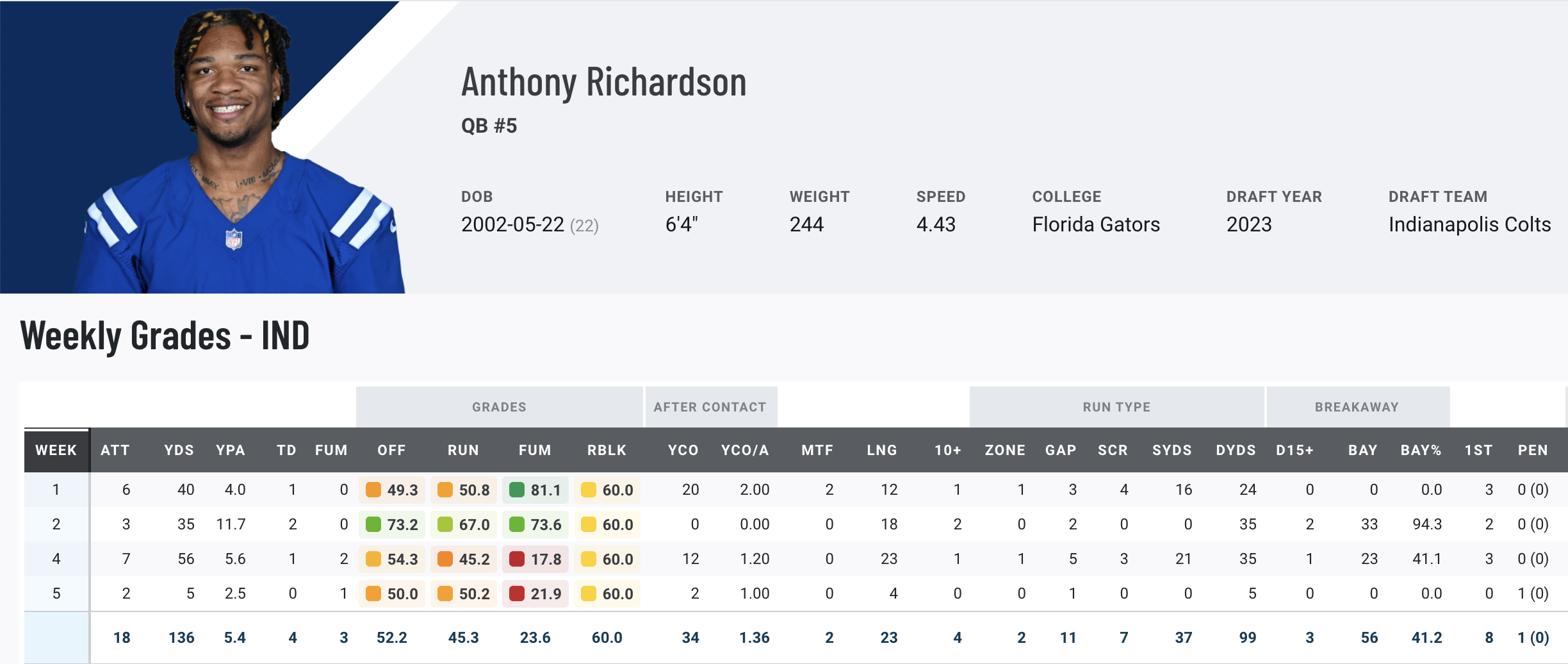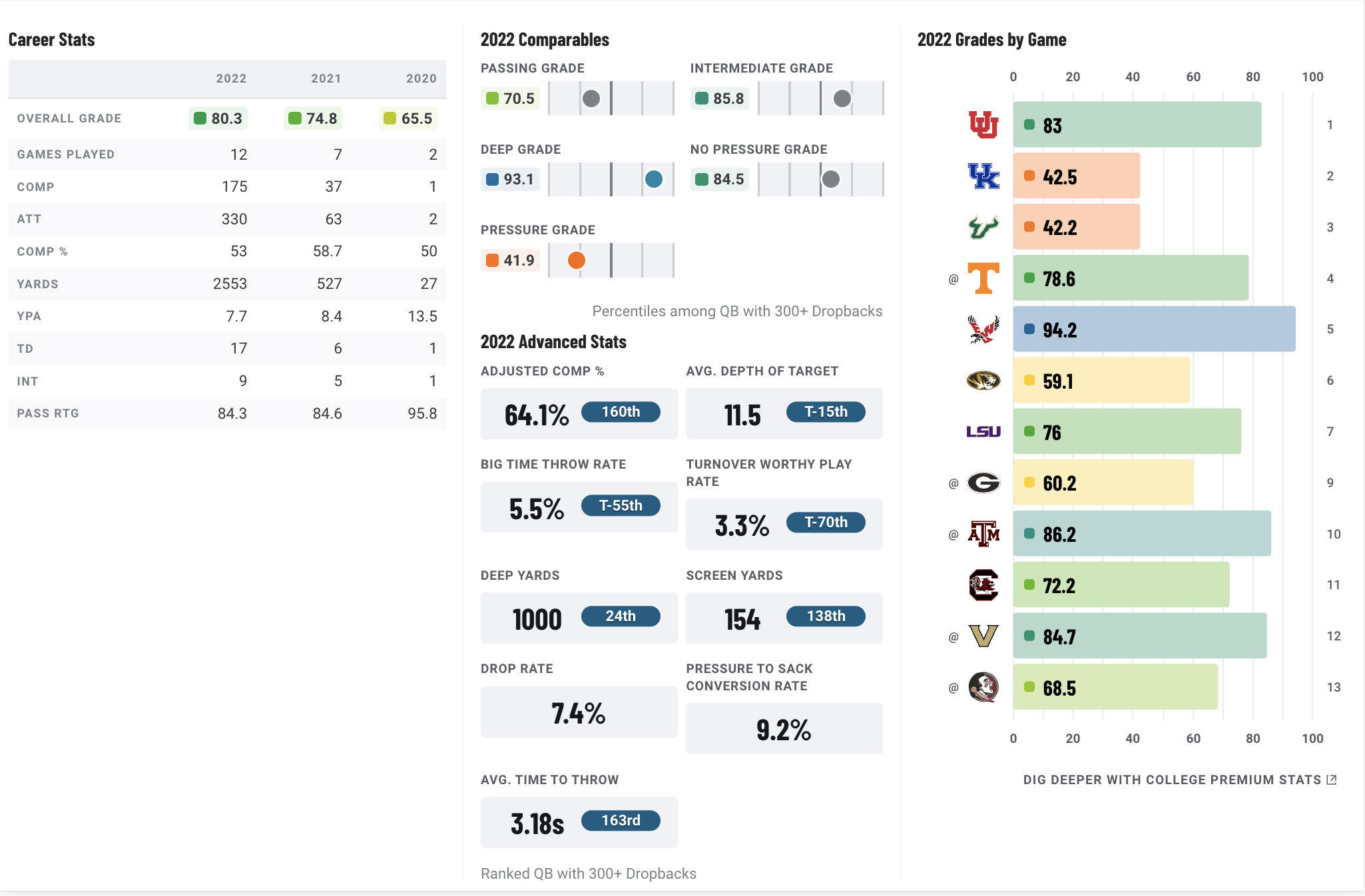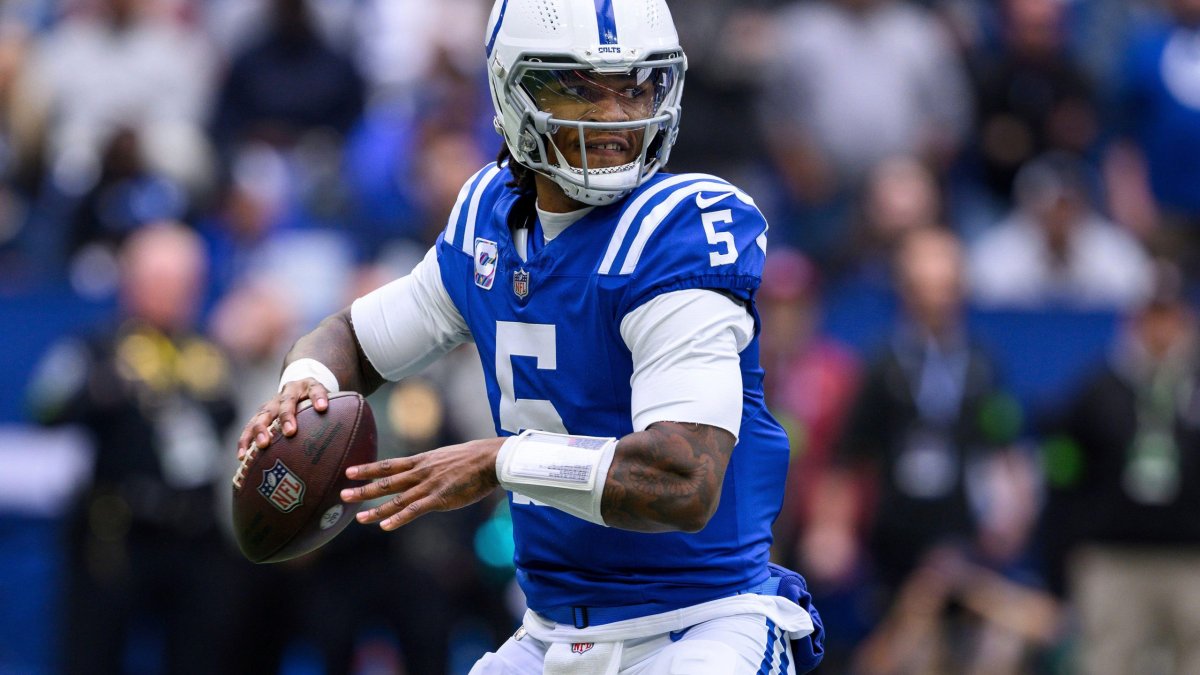• The best athlete the game has ever seen: At 244 pounds, Richardson ran a 4.43-second 40-yard dash, almost two-tenths faster than Cam Newton back in 2011 and three-tenths faster than Josh Allen. Richardson’s vertical leap was over 40 inches, more than five inches better than Newton's.
• The balancing act: The team now needs to decide whether Richardson's rookie-year injury was simply unfortunate, whether it was just the wrong hit at the wrong time at the wrong angle, or whether they were sent a message that their grand plans at quarterback are going to need to look different than they thought they would.
• Get a head start on fantasy football: Use PFF's fantasy football mock draft simulator to create real live mock draft simulations to get ready for your live draft!
Estimated Reading Time: 4 minutes
The Indianapolis Colts saw enough from quarterback Anthony Richardson in his rookie year to be confident in him as the answer going forward. In just four games, the Florida product flashed impressive ability and recorded seven total touchdowns to one interception.
However, those games also showed the perils of relying on a quarterback as a significant part of the designed run game.
Richardson was banged up more than once before suffering a shoulder injury on a hit that was bad enough that it cost him the remainder of the year.

At 6-foot-4 and 244 pounds, Richardson has the size and strength to take physical risks against NFL-caliber defenders. He doesn’t necessarily need to avoid contact at all costs like some smaller quarterbacks do, but this means he exposes himself to the kind of contact those smaller players avoid.
We tend to think of bigger quarterbacks as more robust and less likely to get injured, while smaller passers are inherently more injury-prone.
Several years ago, Football Outsiders published an article that researched this (now no longer available) and suggested that there is actually an inverse correlation between quarterback size and injury rate — i.e., smaller passers get hurt less often and not more often than their bigger counterparts.
Smaller players who take the same hits as bigger players may or may not suffer more damage or be more likely to suffer an injury, but those players adjust for that with their playing style.
Conversely, players like Richardson, Cam Newton or Josh Allen — giant quarterbacks with rare size and strength — tap into those gifts far more regularly than less physically gifted quarterbacks would to try to keep plays alive or gain additional yardage. Exposing themselves to hits that smaller passers would never think about taking is part of what makes them the players they are.
NFL Quarterbacks: Most rushing yards after contact since 2006 (postseason included)
| Name | Attempts | Yards after contact (YCO) | YCO/ATT |
| Cam Newton | 1,178 | 2,956 | 2.51 |
| Lamar Jackson | 948 | 2,837 | 2.99 |
| Josh Allen | 741 | 2,430 | 3.28 |
| Russell Wilson | 1,061 | 1,925 | 1.81 |
| Justin Fields | 356 | 1,388 | 3.90 |
| Deshaun Watson | 399 | 1,182 | 2.96 |
| Jalen Hurts | 572 | 1,175 | 2.05 |
| Tyrod Taylor | 409 | 1,143 | 2.79 |
| Michael Vick | 476 | 1,111 | 2.33 |
| Ryan Fitzpatrick | 557 | 1,044 | 1.87 |
Newton and Allen are the top two quarterbacks in all-time rushing touchdowns. They didn’t amass those scores by running the same plays every other quarterback does. Their size and physicality allow for them to be deployed in different ways. Newton was unique for a time as a quarterback who was running QB-power — a designed run right into the teeth of a defense with no protection other than pulling offensive linemen leading the way.
The upside of this schematic advantage is obvious. A player like that allows an offense to change the math and gain an advantage against a defense. The quarterback is no longer a passive actor on run plays but an active threat to carry the football and make plays.
The Bills are one of the best short-yardage teams in football because Allen can counter almost anything a defense can throw at them to move the chains. Sometimes, that involves taking—or delivering—a big hit to get it done.
The downside to the strategy is that you expose your quarterback to hits that other passers will never be asked to take.
There may not be a “correct” balance to strike between that risk and reward, as any one hit could be the one that injures the most important player on the team, so threading that needle is an added layer of difficulty for any coach with an athletic quarterback.
For the Colts and Shane Steichen, Richardson’s rookie season was the worst-case scenario for the dynamic.
Richardson came into the NFL as the most athletic quarterback the game has ever seen. At 244 pounds, he ran a 4.43-second 40-yard dash, almost two-tenths faster than Newton back in 2011 and three-tenths faster than Allen. Richardson’s vertical leap was over 40 inches, more than five inches better than Newton's.
The Colts drafted a singular athlete at the position, knowing he would provide them with an unmatched athletic threat. But after four games, he had been knocked out of the season with a shoulder injury.
The team now needs to decide whether that was simply unfortunate, whether it was just the wrong hit at the wrong time at the wrong angle, or whether they were sent a message that their grand plans at quarterback are going to need to look different than they thought they would.

If Richardson needs to be protected more from those hits, the full scope of that offense can suffer to a degree. It also accelerates the timetable for Richardson’s development as a passer. When the team could rely on his rushing threat, they could take their time developing his passing. Without that rushing threat, he needs to get more efficient for the offense to remain as effective.
In his four games as a rookie, Richardson’s completion rate was 59.5%, and he passed for 6.9 yards per attempt. Each time Gardner Minshew replaced him, Minshew was more productive as a passer.
Richardson is incredibly inexperienced as a starting quarterback, so it’s not surprising that his passing isn’t yet where it needs to be. He recorded fewer than 500 career dropbacks in college and didn’t add 100 more before being shut down as a rookie.
Anthony Richardson vs. Gardner Minshew: Passing stats in 2023
| Anthony Richardson | Metric | Gardner Minshew |
| 98 | Dropbacks | 546 |
| 50/84 | Comps./Atts. | 305/490 |
| 71.0% | Adjusted comp. % | 74.2% |
| 6.9 | YPA | 6.7 |
| 56.5 | Passing grade | 60.6 |
His rushing ability was supposed to provide a platform to allow him to develop as a passer without undermining the rest of the offense. If that’s no longer on the table, the young quarterback needs to take significant steps forward as a passer much quicker than he would have otherwise.
The Colts were dealt the nightmare scenario last year: a uniquely gifted athletic quarterback who lasted just four games before the risks of tapping into that athleticism came calling.
This offseason, the Colts face an extremely challenging decision that will shape the foundation of this team in the coming years: How much can they actually use Richardson as an athlete above and beyond his abilities as a passer?




 © 2025 PFF - all rights reserved.
© 2025 PFF - all rights reserved.